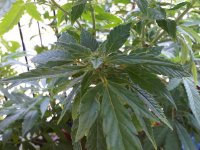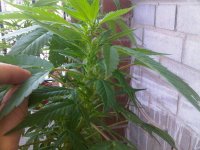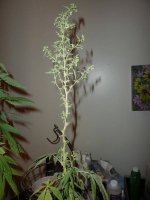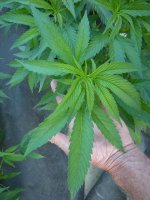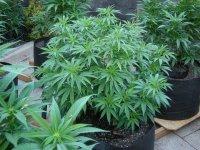greek_mystique
New member
Good day to you sirs,
A short introduction, I have been growing professionally since 1999 predominantly in a commercial fashion whilst dabbling in crossing and breeding from 2001(I joined IC in 2005 but quit posting forums altogether after the OG debacle). I have a backround in biochemistry but really i'm a jack of modern trades. After many close brushes with the law around the country, I was finally bagged on some minor charges and forced to spend the past 2 years on strict probation. This afforded me the opportunity to step back and do some nice slow work on some of my favourite crosses. So in 2008, with sweet tooth being one of my favs over the years I dug out the F1's consisting of the original sweet tooth spg leaning pheno circa ~2000, that i won out of a few packs of seeds at that time and kept for a few years, crossed with a particularly dense and resinous male out of a production northern lights #5 clone from the mid 90s and a very dark, very dense broadleaf Greenhouse White Rhino male.
My goal in the beginning, though it has since changed, was fairly simple. I decided i would be selecting for colour (predominantly looking for scarlets and pinks), flavour(always loved that ST flavour), density and yield(tight internodal distance and flower formation), and potency (dense and abundant trichome formation)in no particular order. My other sidegoal at the time, and now my focus, was to do selection outdoors in ontario and to massage the genetics into performing admirably in marginal environments. More on that later.
F1's- I started 100 seeds and variation was minimal. Leaf morphology, internodal distance, 'branchiness' was remarkably uniform for such a complex hybrid. Growth pattern was single cola dominant, christmas tree. No plants in F1 generation showed colour or pinky purple stems, even with cold nights in the fall. Plants were a uniform medium green. Plants did show ample variation in trichome onset, trichome density, and strength and punchiness of the high(cannabinoid ratios). Varying levels of mold and pest resistance were also observed. Pistils white, majority maturing to deep red. I spread the plants around to grow in varying environments in southern ontario, canada. The 3 most potent males(i smoke the leaves), and females showing varying amounts of disease resistance were isolated and allowed to freely pollinate more towards the end of flowering than I would have liked, allowing me less mature seed for the next gen. Approx. 250 strong viable seeds were produced.
F2's-200 seeds were started for this generation in early may, 2009. As expected, given the relative uniformity of F1, wide variation was observed from the outset giving almost a classical F2 distribution. I operate under an unrelenting rule of only the strongest may survive and as such i subject my breeding plants to a wide range of stressors during the course of their growth. By the end of june, when i was ready to start transplanting outside I was down to 120 plants. Most plants exhibiting no colour were culled, also plants that were 'stretchier' or displaying generally weak growth or otherwise poor qualities. 60 plants were put in the ground in several environments and sixty were held over for a bit and allowed to root bound in beer cups to simulate an unfortunately more common outdoor scenario. They were then grown outdoors in 1 gallon containers also to simulate being plunked in the ground in a marginal area and fed a minimal largely organic diet. Plants showed a large range of performance, however general plant morphology and flower formation was fairly uniform over perhaps 60-70% of the population. The majority with ample resin and potency. Flavour and odour was very broad, ranging from nearly no smell at all, to skunkier, to astringent, to fruity, and to sweet tooth. i chose 2 plants from both populations, both male and female, to create the F3. I selected the ground plants for colour(i didn't get to breed the pinkiest which still makes me sad, had to settle for purpley), flavour(sweet tooth dominant or strong undertone), potency and vigor, but also fast flowering, they were done by the 3rd or 4th week of september. The 1 gallon plants I selected for the same traits but chose the best yielders over the best flavours, the 2 fems produced approx. 3 ozs (most plants hovered around 1-2ozs)while still exhibiting some colour and retaining the base sweet tooth terpene profile with a denser trichome distribution(also finishing at the same time). Males were selected based on potency, internodal distance, less 'branchiness', as well as vigor and flowering period. Because of the logistics and the limitations of probation I was a little late in pollinating and aquired approx. 150 viable seeds.
F3's- Ah finally the subject of my first post in years! 140 of 150 seeds were started in early may, 2010. The genetic variation was vast, and largely unexpected. This generation produced more variability than was observed over F2 in that there were more recessive combinations. Because of new limitations and conditions and new bails, etc. I shacked up with my dad this year and as such i had to practice a more vigorous culling than i would normally. Because of the constant harping, I was forced to cull as soon as the plants showed sex. As such I selected without knowing the final profiles of each plant, which though unfortunate, may have provided me with new opportunities. I selected 2 males based on vigour, internodal distance, stem colouring, and strength and quality of odour from the rubbed stems. The females, essentially the same selection, although knowing that stem odour isn't a very reliable indicator of the final terpenoid profile, i kept a few extra that pleased me in some other fashion. I kept 5. And whats developed has been both beyond my expectation for this stage, as well as a little less than stellar in other areas. But from chaos comes order, and i'm pretty excited to work with these developments going forward.
I'll be keeping up this post on the progress of these selections. I'll leave alot to be answered for now as this post became longer than i anticipated. I'll be detailing each plant in my next post tomorrow, as I'm borrowing a camera tonight to take more pictures(im trying to post a couple from a blackberry now). But let me just say that things are looking very interesting indeed with a surprise or two in store, and you may want to stick around!
note* these pics are from 12 days ago, july 22.
A short introduction, I have been growing professionally since 1999 predominantly in a commercial fashion whilst dabbling in crossing and breeding from 2001(I joined IC in 2005 but quit posting forums altogether after the OG debacle). I have a backround in biochemistry but really i'm a jack of modern trades. After many close brushes with the law around the country, I was finally bagged on some minor charges and forced to spend the past 2 years on strict probation. This afforded me the opportunity to step back and do some nice slow work on some of my favourite crosses. So in 2008, with sweet tooth being one of my favs over the years I dug out the F1's consisting of the original sweet tooth spg leaning pheno circa ~2000, that i won out of a few packs of seeds at that time and kept for a few years, crossed with a particularly dense and resinous male out of a production northern lights #5 clone from the mid 90s and a very dark, very dense broadleaf Greenhouse White Rhino male.
My goal in the beginning, though it has since changed, was fairly simple. I decided i would be selecting for colour (predominantly looking for scarlets and pinks), flavour(always loved that ST flavour), density and yield(tight internodal distance and flower formation), and potency (dense and abundant trichome formation)in no particular order. My other sidegoal at the time, and now my focus, was to do selection outdoors in ontario and to massage the genetics into performing admirably in marginal environments. More on that later.
F1's- I started 100 seeds and variation was minimal. Leaf morphology, internodal distance, 'branchiness' was remarkably uniform for such a complex hybrid. Growth pattern was single cola dominant, christmas tree. No plants in F1 generation showed colour or pinky purple stems, even with cold nights in the fall. Plants were a uniform medium green. Plants did show ample variation in trichome onset, trichome density, and strength and punchiness of the high(cannabinoid ratios). Varying levels of mold and pest resistance were also observed. Pistils white, majority maturing to deep red. I spread the plants around to grow in varying environments in southern ontario, canada. The 3 most potent males(i smoke the leaves), and females showing varying amounts of disease resistance were isolated and allowed to freely pollinate more towards the end of flowering than I would have liked, allowing me less mature seed for the next gen. Approx. 250 strong viable seeds were produced.
F2's-200 seeds were started for this generation in early may, 2009. As expected, given the relative uniformity of F1, wide variation was observed from the outset giving almost a classical F2 distribution. I operate under an unrelenting rule of only the strongest may survive and as such i subject my breeding plants to a wide range of stressors during the course of their growth. By the end of june, when i was ready to start transplanting outside I was down to 120 plants. Most plants exhibiting no colour were culled, also plants that were 'stretchier' or displaying generally weak growth or otherwise poor qualities. 60 plants were put in the ground in several environments and sixty were held over for a bit and allowed to root bound in beer cups to simulate an unfortunately more common outdoor scenario. They were then grown outdoors in 1 gallon containers also to simulate being plunked in the ground in a marginal area and fed a minimal largely organic diet. Plants showed a large range of performance, however general plant morphology and flower formation was fairly uniform over perhaps 60-70% of the population. The majority with ample resin and potency. Flavour and odour was very broad, ranging from nearly no smell at all, to skunkier, to astringent, to fruity, and to sweet tooth. i chose 2 plants from both populations, both male and female, to create the F3. I selected the ground plants for colour(i didn't get to breed the pinkiest which still makes me sad, had to settle for purpley), flavour(sweet tooth dominant or strong undertone), potency and vigor, but also fast flowering, they were done by the 3rd or 4th week of september. The 1 gallon plants I selected for the same traits but chose the best yielders over the best flavours, the 2 fems produced approx. 3 ozs (most plants hovered around 1-2ozs)while still exhibiting some colour and retaining the base sweet tooth terpene profile with a denser trichome distribution(also finishing at the same time). Males were selected based on potency, internodal distance, less 'branchiness', as well as vigor and flowering period. Because of the logistics and the limitations of probation I was a little late in pollinating and aquired approx. 150 viable seeds.
F3's- Ah finally the subject of my first post in years! 140 of 150 seeds were started in early may, 2010. The genetic variation was vast, and largely unexpected. This generation produced more variability than was observed over F2 in that there were more recessive combinations. Because of new limitations and conditions and new bails, etc. I shacked up with my dad this year and as such i had to practice a more vigorous culling than i would normally. Because of the constant harping, I was forced to cull as soon as the plants showed sex. As such I selected without knowing the final profiles of each plant, which though unfortunate, may have provided me with new opportunities. I selected 2 males based on vigour, internodal distance, stem colouring, and strength and quality of odour from the rubbed stems. The females, essentially the same selection, although knowing that stem odour isn't a very reliable indicator of the final terpenoid profile, i kept a few extra that pleased me in some other fashion. I kept 5. And whats developed has been both beyond my expectation for this stage, as well as a little less than stellar in other areas. But from chaos comes order, and i'm pretty excited to work with these developments going forward.
I'll be keeping up this post on the progress of these selections. I'll leave alot to be answered for now as this post became longer than i anticipated. I'll be detailing each plant in my next post tomorrow, as I'm borrowing a camera tonight to take more pictures(im trying to post a couple from a blackberry now). But let me just say that things are looking very interesting indeed with a surprise or two in store, and you may want to stick around!
note* these pics are from 12 days ago, july 22.
Attachments
Last edited:

